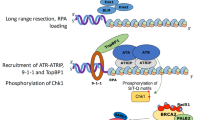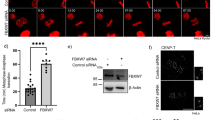Abstract
Using C-banded preparations of Mus dunni it is possible to study the behavior of constitutive heterochromatin in early stages of meiotic prophase. The X and the Y chromosomes, both of which contain a large amount of heterochromatin, lie apart in leptotene but move toward each other during zygotene. They then form the sex vesicle at late zygotene. In autosomes zygotene pairing appears to start from the telomeric ends. The centromere of the Y chromosome associates end-to-end with the terminal end of the long arm of the X chromosome. The autosomal heterochromatic short arms show forked morphology in certain bivalents at pachytene, suggesting probable incomplete synapsis.
Similar content being viewed by others
References
Benirschke, K.: The chromosome complement and meiosis of the North American Porcupine. J. Hered. 59, 71–76 (1968)
Fredga, K., Santesson, B.: Male meiosis in the Syrian, Chinese, and European hamsters. Hereditas (Lund) 52, 36–48 (1964)
Hsu, T.C.: Constitutive heterochromatin (C-band) technique. In: Chromosome identification: Techniques and applications in biology and medicine (T. Caspersson and L. Zech, eds.). Nobel Symposium 23, 32–33 (1973)
Hsu, T.C., Cooper, J.E.K., Mace, M.L., Jr., Brinkley, B.R.: Arrangement of centromeres in mouse cells. Chromosoma (Berl.) 34, 73–87 (1971)
Kofman-Alfaro, S., Chandley, A.C.: Meiosis in the male mouse. An autoradiographic investigation. Chromosoma (Berl.) 31, 404–420 (1970)
Lavappa, K.S., Yerganian, G.: Spermatogonial and meiotic chromosomes of the Armenian hamster, Cricetulus migratorius. Exp. Cell Res. 61, 159–172 (1970)
Markvong, A., Marshall, J.T., Pathak, S., Hsu, T.C.: Chromosomes and DNA of Mus: The karyotypes of M. fulvidiventris and M. dunni. Cytogenet. Cell Genet. 14, 116–125 (1975)
Natarajan, A.T., Gropp, A.: The meiotic behavior of autosomal heterochromatic segments in hedgehogs. Chromosoma (Berl.) 35, 143–152 (1971)
Pathak, S., Hsu, T.C., Markvong, A.: Pachytene mapping of the male Chinese hamster. Cytogenet. Cell Genet, (in press, 1976)
Polani, P.E.: Centromere localization at meiosis and the position of chiasmata in the male and female mouse. Chromosoma (Berl.) 36, 343–374 (1972)
Schnedl, W.: End-to-end association of X and Y chromosome in mouse meiosis. Nature (Lond.) New Biol. 236, 29–30 (1972)
Sharma, T., Pathak, S., Ray-Chaudhuri, S.P.: Large sex chromosomes of Indian house shrew Suncus murinus (L). The Nucleus (Calcutta) 13, 62–69 (1970)
Solari, A.J.: The behavior of the XY pair in mammals. Int. Rev. Cytol. 38, 273–317 (1974)
Unakul, W., Hsu, T.C.: Induction of chromosome banding in early stages of spermatogenesis by ethidium bromide. Chromosoma (Berl.) 44, 285–290 (1973)
Zenzes, M.T., Wolf, U.: Paarungsverhalten der Geschlechtschromosomen in der mannlichen meiose von Microtus agrestis. Chromosoma (Berl.) 33, 41–47 (1971)
Author information
Authors and Affiliations
Rights and permissions
About this article
Cite this article
Pathak, S., Hsu, T.C. Chromosomes and DNA of Mus . Chromosoma 57, 227–234 (1976). https://doi.org/10.1007/BF00295209
Received:
Accepted:
Issue Date:
DOI: https://doi.org/10.1007/BF00295209




